An unexpected and important find in Tatoi, discovered while documenting cultural values and movable property – the royal regalia of the first king of Greece, Otto: a crown, a sword, a scepter.
They were discovered in the course of work on documenting cultural property and movable property, carried out by the competent services of the Ministry of Culture. The royal regalia, about which much has been said and many guesses, often bizarre, have been found in very good condition, perfectly preserved and carefully packaged.
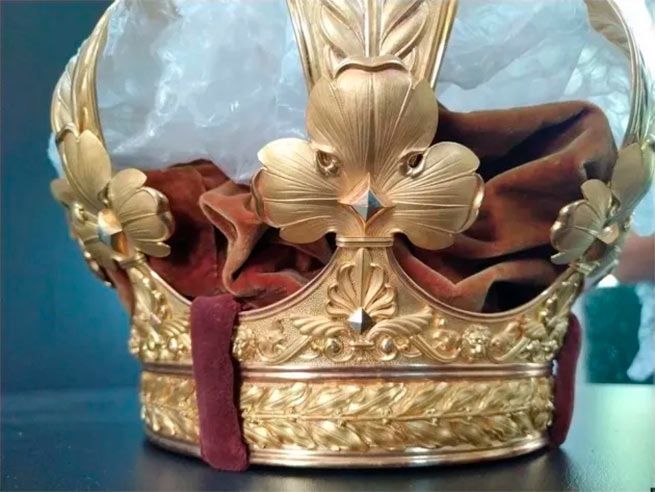
Crown of King Otto. Material: gold and gilded metal, enamel, velvet. Dimensions: height 25 cm, maximum diameter 29 cm.
Minister of Culture Lina Mendoni, having received information about the find, stated the following: “I want to thank the competent services of the Ministry of Culture for the extremely painstaking, systematic, scientific work that they have carried out in recent years in Tatoi. The discovery of the royal emblems of Otto, King of Greece, was unexpected. Their significance for the Greek state is extraordinarily great, regardless of the constitutional changes that have taken place.They are the first official insignia of the new Greek state and bear tangible traces of its continuity over time.It is clear that the royal regalia belong to the Greek people and nation.After the completion of conservation, these objects will be handed over to the Greek Parliament, in agreement with the Prime Minister and the Speaker, to be permanently displayed in the Eleftherios Venizelos Trophy Hall.
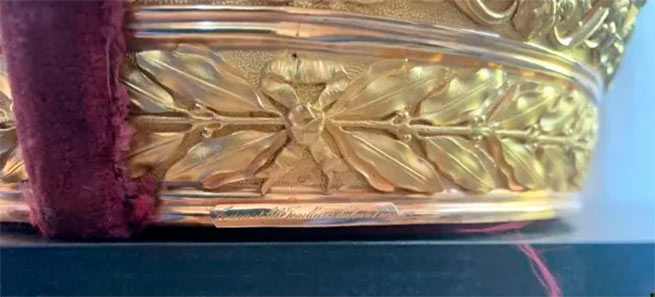
Close-up of Otto’s crown. It is decorated with a wreath with a floral strip resembling a laurel wreath. At this place there is an epigraph with the signature of the artist. From here there are eight arches, decorated with antique acanthus leaves and a lion’s head, from which eight arched stems grow in the form of palm branches. The whole composition is connected in the center, where the crown is topped with a globe, below the cross. The purple velvet on the inside is preserved, but has significant wear.
Otto, Prince of Bavaria of the House of Wittelsbach, reigned in Greece with the title “King of Greece” from 1832 to 1862. The crown and scepter were made by the renowned Parisian jewelers Fossin et Fils, while the sword was made by Fossin, in collaboration with the swordsman of the same name, Jules (?) Manso.
The swords were commissioned by Louis of Bavaria, Otto’s father, in 1835 to be presented to the young king at his coronation, which was to take place the same year he came of age. However, the ship carrying them did not arrive in Greece in time, and the coronation took place without them. Otto, leaving Greece in 1862, took with him the emblems of the throne, as he did not reconcile himself to exile and did not abdicate. Thus, the first emblems of the Greek state since 1862 were at the disposal of the Bavarian royal house.
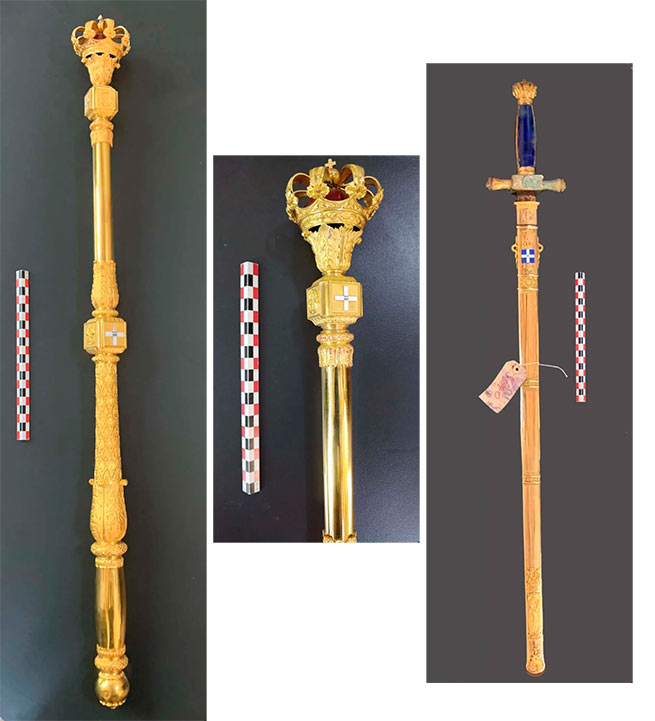
Scepter and sword of Otto.
Scepter with Otto’s monogram. Material: gold and gilded metal, enamel. Dimensions: height 78 cm, maximum thickness 7.4 cm. Inscription: Fossin et fils Joailliers du Roi à Paris.
The scepter consists of three elongated stems connected by decorated handles. The upper part is crowned with a full-figured crown, the inner surface of which is decorated with enamel. The top cubic connecting handle alternates decoration with Otto’s monogram and enamel with a white cross. At the junction of the antennas, the colors of the Bavarian flag are visible. This is followed by a stem without decor and a sleeve with a corresponding decor, where instead of Otto’s monogram, full-length lions are depicted. The central leg is completely decorated with acanthus floral decoration. The lower leg ends with a ball with a floral ornament. This place is engraved with the inscription of the manufacturer.
Otto’s sword with the state emblem. Material: gold and gilded metal, enamel, lapis lazuli. Dimensions: height 92 cm, width 12.7 cm. Inscription: Manceaux Fabricant d’armes et Fossin et Fils Joailliers du Roi à Paris.
The sword has an elaborately decorated hilt and scabbard, dominated by floral and animal motifs. The hilt is formed from lapis lazuli stone and ends with a knob on which two female figures are depicted in relief. The decor continues on the cross formed by the horizontal stems of the finger guard. On the upper edge of the case, the monogram of Otto is depicted in relief, followed by the coat of arms of Greece, made in enamel. On the reverse side there is a space with the inscription of the manufacturer. The holes for hanging the sword are formed by slithering snakes. The whole composition is surrounded by a thin ribbon of lion heads. At the base of the scabbard is a female figure, probably Nike, surrounded by a palm-shaped medal, and war trophies are visible in the background. In the lower decorative strip on both sides there is an applied decor with dolphins twining around a trident.
Items made of gold and metal alloys are distinguished by the high craftsmanship of their authors. They are quite simple, do not contain precious stones (with the exception of lapis lazuli on the sword handle), but the symbolism of their decorative elements is significant. It is with them that the tradition of forming state symbols begins, which developed over the next two centuries, despite the change of dynasties and states.
The last time all three coats of arms were presented together in December 1959, at the ceremony of their presentation by the House of Wittelsbach to the then King Paul of Greece. After diplomatic negotiations, the head of the House of Wittelsbach, Albert, offered the emblems of the throne back to Greece. The handover ceremony took place at the Athens Palace (now the Presidential Palace) in December 1959, in the presence of Prime Minister Konstantinos Karamanlis and cabinet ministers. The date was chosen taking into account the anniversary of Otto’s arrival in Athens in 1834 and the proclamation of the city as the capital of the new Greek kingdom. Albert’s son Maximilian-Emmanuel presented the first emblems of the Greek throne to the royal couple on a symbolic day for the state and its capital. The crown was used at the funeral of King Paul in March 1964 and at the funeral of former Queen Frederica in February 1981.
Despite the very good preservation, the Directorate for the Preservation of Ancient and Modern Monuments of the Ministry of Culture has already taken measures due to the long period of their storage. Available references, including a scientific publication, allow them to be identified. Certainly, further study and research is required, and this task is already being solved by employees. directorates.



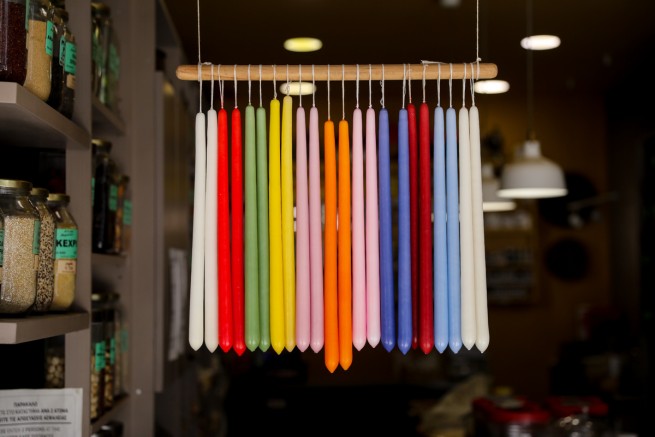

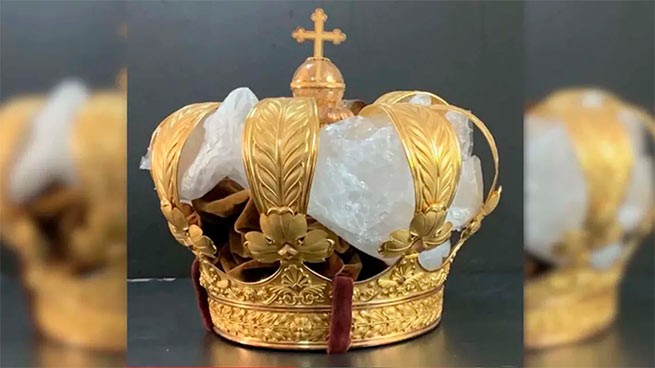

More Stories
The Olympic flame began its journey to Marseille on the sailing ship Belen
Butter babies "lazarakia"
Olympic torch relay: traffic restrictions in Athens and Attica on Friday